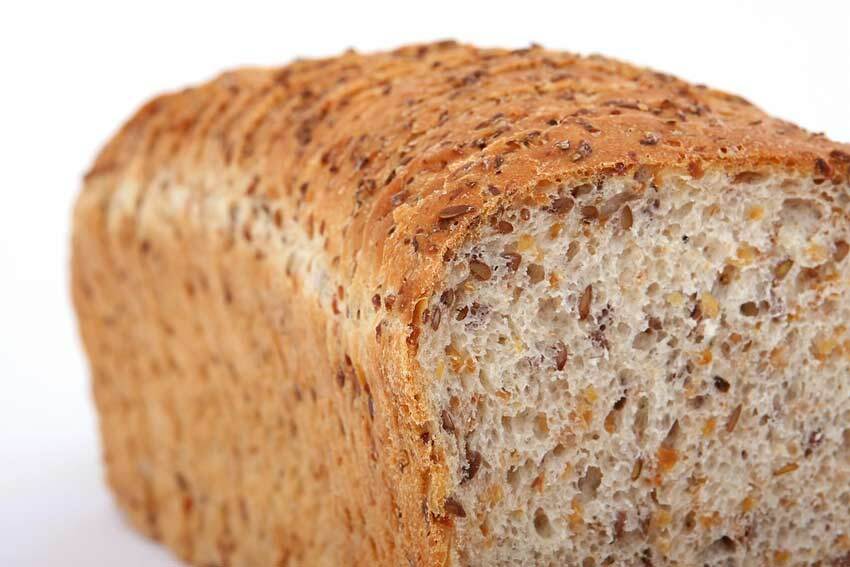
Page Contents
- 1 What is the glycemic index of products?
- 2 Why do I need a glycemic index?
- 3 Glycemic Index for Diabetes Mellitus
Foods with a high glycemic index should be considered for a variety of health problems. This applies primarily to patients with diabetes mellitus and other endocrine diseases. In addition, this indicator is important to consider those who seek to normalize body weight, athletes, patients recovering from severe illness and injury. In each specific case, the definition of the glycemic index( GI) has different purposes. Let's talk about this in more detail and learn more about products with high GI.
What is the glycemic index of products?

To begin with, most foods contain different carbohydrates. These can be simple sugars - glucose and fructose, disaccharides - sucrose and lactose, as well as complex sugars - starch and fiber. All these carbohydrates( except cellulose) are digested in the body with the help of special enzymes, and enter the blood in the form of glucose, less often fructose. Glycemic index reflects how quickly glucose from food enters the blood.
Usually, when talking about the glycemic index, then apply this concept to products containing a large number of carbohydrates. This is due to the fact that at a high rate of splitting and absorption of glucose, a large amount of carbohydrates immediately enters the bloodstream, which can cause a sudden change in the state of health in patients suffering from diabetes mellitus. Therefore, it is important for diabetics to take into account the GI of products and to make a correct diet in order to avoid undesirable complications.
Foods consisting mainly of protein, fat or fiber cause a gradual and small increase in the level of glucose, which makes their glycemic index less important. The following foods are considered to be sources of fast carbohydrates:

- sugar;
- sweets( sweets, chocolate, confectionery);
- sweet fizzy drinks;
- semi-finished products( porridges and instant soups);
- potato and other products with a high content of starch;
- alcoholic beverages.
These products contain simple( fast) carbohydrates, which consist of only one or two saccharides. With the use of the product, simple carbohydrates almost instantaneously give up their energy and sharply increase the level of glucose in the blood.
If this energy remains unclaimed( which is most often the case with people who have a sedentary lifestyle), it quickly converts to fat stores that are deposited on the abdomen and on the sides. At the same time, fast carbohydrates do not give a long-lasting sense of satiation and hunger quickly returns, forcing a person to constantly snack with harmful food.
Why do I need a glycemic index?

This indicator is determined when there is a need to adjust the patient's diet. It will not be superfluous in everyday life. Glycemic index of products is necessarily taken into account when compiling the ration of athletes and ordinary people leading a healthy lifestyle.
The glycemic index is divided into:
- Low ( up to 40) - the product causes a slow and gradual increase in glucose levels, which lasts for several hours;
- Medium ( 40-70) - the product causes a slight and rather rapid increase in blood sugar, which stops for a short time;
- High ( above 70) - the product sharply increases the glucose level to large digits, then the same rapid decrease in indices occurs.
It can not be said that the use of products with low GI is definitely preferable. It all depends on what purpose the patient and the doctor set themselves, choosing a particular diet.
For example, in diabetes mellitus, products with low GI allow better control of blood glucose levels, and products with high glucose make it easier to feel good during hypoglycemia. That is, with a sharp drop in blood sugar, a product with a high glycemic index will quickly help stabilize the condition.
With obesity, products with a low glycemic index maintain a feeling of satiety, allowing you to reduce the number of meals a day, but products with a high glycemic index should be avoided. In sports nutrition, the balance of products with low and high GI is very important in order to maintain the optimal level of glucose in the blood during and after training.
Products with an average glycemic index( and this group includes chocolate bars, fillings, sweet fruit juices) occupy an intermediate position. They do not have a harmful effect on the body, if they are used in moderation, but their infatuation leads to problems with excess weight, sharp jumps in blood sugar levels in diabetics and a decrease in athletes' results.
Glycemic Index for Diabetes Mellitus

In diabetes mellitus, menu design plays an important, if not decisive, role in the treatment of the disease. Without a properly organized diet, the effectiveness of medications will decrease, and the patient's well-being will deteriorate. The definition of the glycemic index allows you to make the most useful menu. At the same time, a small list of products with a high glycemic index should be present in the diet of a diabetic.
The purpose of a diet for diabetes is to achieve a constant level of blood glucose within the norm. In this respect, certain rules apply. For example, if sugar is increased, it should be reduced gradually, and the rate of such reduction is often very small. This is due to the fact that a sharp decrease in the level of glucose in the blood will lead to phenomena similar to hypoglycemia.
Hypoglycemia is another danger that lies in wait for diabetics, especially those with poorly controlled forms of type 1 diabetes. This is a sharp decrease in blood sugar, which causes a deterioration in well-being, and sometimes can lead to severe conditions, such as coma. Most often, low sugar is observed in the morning.
As carbohydrates enter the body unevenly, the blood glucose level also fluctuates after them, then exceeding the norm, then being on the verge of hypoglycemia. For a healthy person, a sharp increase in the level of glucose after eating is normal, and goes on by itself. In a diabetic, a high level of glucose can last for a long time, increasing the risks of various diseases, since own insulin does not control glycemia.
To avoid this, fractional food is recommended with a uniform distribution of products over the energy value during the day. Should prevail foods with a low glycemic index, maintaining a normal level of glucose throughout the day.
Products with medium GI
Products with medium GI are added, based on the patient's condition and blood glucose level. Products with high GI, causing sudden jumps of glucose, are completely excluded as far as possible. They are used only for hypoglycemia in order to quickly restore blood sugar and avoid serious health consequences.
The glycemic index reflects the dynamics of glucose digestion and absorption, that is, a change in its concentration for several hours. This is a very accurate indicator, but most often they are operated by endocrinologists and nutritionists. In practice, it is much more convenient for patients to use another unit of glucose measurement in foods-the bread unit.
This is less accurate, but more convenient for calculation, the indicator that allows you to take into account the eaten products not only qualitatively, but also quantitatively. Roughly speaking, the glycemic index determines what foods will be on the patient's table, and grain units - how much food can he eat without harm to himself.
Glycemic index when losing weight

When preparing the menu for patients who wish to normalize weight, the same principles are used as for patients with diabetes mellitus. Stably high blood glucose level within the norm will allow the patient to feel full, while using less products. Therefore, it is recommended fractional food and the use of products that raise the level of glucose slightly, but for a long time. In the case of obesity, the frames are less strict, and you can afford some products with an average glycemic index, for example, some fruits.
With obesity, the diet exhibits sufficient flexibility, depending on how strongly the disease is expressed in a particular patient. Just as in the case of diabetes mellitus, the patient can not quickly lose weight - this will negatively affect his health and well-being, so a gradual but steady decrease in body weight is necessary.
As is known, products with high GI are very quickly cleaved in the body, increasing blood sugar level, and thereby stimulate the pancreas to release insulin. In turn, insulin helps to distribute sugar throughout the tissues of the body, and its excess is put in reserve, converting it into subcutaneous fat.
Discard products with high GI
That is, if in your daily diet there are products with a high glycemic index, then the release of insulin occurs regularly, and so does fat storage.
Therefore, those who want to lose weight should radically revise their diet and first of all give up products with high GI.Only by changing the style of nutrition, and by increasing the motor activity, you create the conditions for weight loss and the conversion of fat back to glucose, which will supply the body with the necessary energy.
The diet is formed on the basis of products that have a low or medium glycemic index. To avoid negative effects on body weight, a table of products with a high glycemic index is used. The patient should be guided by it in the formulation of the diet and avoid using the products indicated in the table:
List of products with a high glycemic index

| Name | GI( glycemic index) |
| Beer | 110 |
| Sugar | 70 |
| Potato chips | 70 |
| Fried and baked potato, potato casserole | 95 |
| Chocolatemilk | 70 |
| Soda | 70 |
| Milk porridge( rice, millet) | 75 |
| Crackers | 80 |
| Semolina | 70 |
| White bread "Wheaten" | 100 |
| Burger biscuit | 85 |
| Muesli with nuts | 80 |
| White rice | 90 |
| Date( s) | 103 |
| Apricots canned | 91 |
| Watermelon | 75 |
| Carrots( braised, boiled) | 85 |
| Corn flakes | 85 |
| Wafers( unsweetened) | 75 |
| Millet | 71 |
It should be recalled that hypoglycemic conditions are not only in patients with diabetes, they can be an incidentaleffect of the desire to make your diet healthier. Therefore, even for patients seeking to normalize their weight, it is not contra-indicated the presence in the diet of products with a high glycemic index.
These are products that need to be limited, but in some cases they can significantly improve health. For example, the use of products with a high GI is recommended for grueling workouts or performing heavy physical work.
How can I reduce the glycemic index?
 Photo: bread from linseed flour
Photo: bread from linseed flour There are several secrets that will help reduce the glycemic index of products and will help to speed up the process of losing weight:
- regular bread is replaced with whole grains, the porridge is also cooked from whole grains that are not subjected to additional processing;
- foods high in carbohydrates are consumed simultaneously with proteins;
- in food is added a little fat( vegetable or butter), which slows the absorption of carbohydrates;The starchy foods are eaten simultaneously with vegetables that have a low glycemic index;
- uses fresh fruits and vegetables instead of juices, which contain useful fiber, which improves digestion and slows the conversion of simple carbohydrates into fats.
The appointment of a diet, including based on the account of the glycemic index of products, should only be performed by a doctor. Self-medication can lead to dangerous consequences and undesirable complications. Therefore, make a diet should be combined with an experienced nutritionist. Only in this case, the restrictions will benefit and help get rid of excess weight and other health problems.


